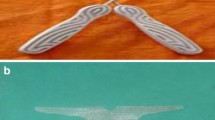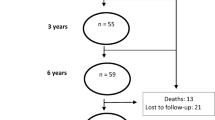Abstract
This study describes an original surgical technique for the correction of medium/high-degree cystocele using a tension-free way to apply a polypropylene mesh: the “tension-free cystocele repair” (TCR). About 218 patients were available with a mean follow-up of 38 months. This technique showed an elevated rate of anatomic correction (75.7%), a statistically significant correction of storage symptoms (48.6 vs 32.5%, p < 0.05), voiding symptoms (40.3 vs 8.3%, p < 0.05), and symptoms associated with pelvic organ prolapse (POP; 55.9 vs 11.4%, p < 0.0001), with no negative impact on ano-rectal function and, in particular, on constipation. The percentage of erosions was 12.3%, but in the group where hysterectomy was not performed, we had erosions in only 2.5%. With the exception of the Personal Relationship domain, all of the categories examined by the Prolapse Quality of Life Questionnaire showed a statistically significant improvement, which confirms the positive impact of this surgery as perceived by patients.




Similar content being viewed by others
References
Beck RP (1990) Pelvic relaxation prolapse. In: Kase NG, Weingold AB (eds) Principles and practice of clinical gynecology. Wiley, New York, pp 677–685
Olsen AL, Smith VJ, Wergstrom JO, Colling JC, Clark AL (1997) Epidemiology of surgically managed pelvic organ prolapsed and urinary incontinence. Obstet Gynecol 89:501–506
Weber AM, Walters MD, Piedmonte MR, Ballard LA (2001) Anterior colporrhaphy: a randomized trial of three surgical techniques. Am J Obstet Gynecol 185(6):1299–1304 discussion 1304–1306)
Sand PK, Koduri S, Lobel RW, Winkler HA, Tomezsko J, Culligan PJ, Goldberg R (2001) Prospective randomized trial of polyglactin 910 mesh to prevent recurrence of cystoceles and rectoceles. Am J Obstet Gynecol 184(7):1357–1362 discussion 1362–1364)
Holley RL, Varner RE, Gleason BP et al (1995) Recurrent pelvic support defects after sacrospinous ligament fixation for vaginal vault prolapse. J Amer Coll Surg 180:444–448
Olsen AL, Smith WJ, Berstrom JO, Colling JC, Clarke AL (1997) Epidemiology of surgically managed pelvic organ prolapse and urinary incontinence. Obstet Gynecol 89(4):501–506
Richardson AC, Edmonds PB, Williams NL (1981) Treatment of stress urinary incontinence due to paravaginal defect. Obstet Gynecol 57(3):357–362
Bump RC, Mattiasson A, Bo K, Brubaker LP, DeLancey JO, Karskov P, Shull BL, Smith AR (1996) The standardization of terminology of female pelvic organ prolapse and pelvic floor dysfunction. Am J Obstet Gynecol 175(1):10–17
Digesu GA, Santamato S, Kullar V, Santillo V, Digesu A, Cormio G, Loverro G, Selavggi L (2003) Validation of an Italian version of prolapse quality of life questionnaire. Eur J Obstet Gynecol Reprod Biol 106(2):184–192
DeLancey JOL (1994) Structural support of the urethra as it relates to stress urinary incontinence: the hammock hypothesis. Am J Obstet Gynecol 170:1713–1723
Porges RF, Smilen SW (1994) Long-term analysis of the surgical management of pelvic support defect. Am J Obstet Gynecol 171:1518–1528
Flood CG, Drutz HP, Waja L (1998) Anterior colporraphy reinforced with Marlex mesh for the treatment of cystocele. Int Urogynecol J 9:200–204
Morley GW, DeLancey JOL (1998) Sacrospinous ligament fixation for eversion of the vagina. Am J Obstet Gynecol 158:872–881
Holley RL, Varner RE, Gleason BP et al (1995) Recurrent pelvic support defects after sacrospinous ligament fixation for vaginal vault prolapse. J Amer Coll Surg 180:444–448
Raz S, Klutke CG, Golomb J (1989) Four-corner bladder and urethral suspension for moderate cystocele. J Urol 142(3):712–715
Miyazaki FS, Miyazaki DW (1994) Raz four-corner suspension for severe cystocele: Poor results. Int Urol J 5:94–97
Richardson AC, Edmonds PB, Williams NL (1981) Treatment of stress urinary incontinence due to paravaginal defect. Obstet Gynecol 57(3):357–362
Benson JT (1992) Female pelvic floor disorders. Norton, New York
Birch C (2005) The use of prosthetics in pelvic reconstructive surgery. Best practice and research. Clin Obstet Gynaecol 19(1):979–991
Farrell SA, Dempsey T, Geldenhuys L (2001) Histologic examination of “fascia” used in colporraphy. Obstet Gynecol 98(5Pt1):794–798
Barber MD, Visco AG, Weidner AC, Amudsen CL, Bump RC (2000) Bilateral uterosacral ligament vaginal vault suspension with site-specific endopelvic fascia defect repair for the treatment of pelvic organ prolapse. Am J Obstet Gynecol 2 183(6):1402–1410
Nicita G (1998) A new operation for genitourinary prolapse. J Urol 160(3 Pt 1):741–745
Mage P (1999) Interposition of a synthetic mesh by vaginal approach in the cure of genital prolapse. J Gynecol Obstet Biol Reprod (Paris) 28(8):825–829
Migliari R, Usai E (1999) Treatment results using a mixed fiber mesh in patients with grade IV cystocele. J Urol 161(4):1255–1258
Dwyer PL, O’Reilly BA (2004) Transvaginal repair of anterior and posterior compartment prolapse with Atrium polypropylene mesh. BJOG 111(8):831–836
Gomelsky A, Rudy DC, Dmochowski RR (2004) Porcine dermis interposition graft for repair of high grade anterior compartment defects with or without concomitant pelvic organ prolapse procedures. J Urol 171(4):1581–1584
Milani R, Salvatore S, Soligo M, Pifarotti P, Meschia M, Cortese M (2005) Functional and anatomical outcome of anterior and posterior vaginal prolapse repair with prolene mesh. BJOG 112(1):107–111
Gandhi S, Goldberg RP, Kwon C, Koduri S, Beaumont JL, Abramov Y, Sand PK (2005) A prospective randomized trial using solvent dehydrated fascia lata for the prevention of recurrent anterior vaginal wall prolapse. Am J Obstet Gynecol 192(5):1649–1654
De Tayrac R, Deffieux X, Gervaise A, Chauveaud-Lambling A, Fernandez H (2006) Long-term anatomical and functional assessment of trans-vaginal cystocele repair using a tension-free polypropylene mesh. Int Urogynecol J Pelvic Floor Dysfunct 17(5):483–488
De Tayrac R, Gervaise A, Chauveaud A et al (2005) Tension-free polypropylene mesh for vaginal repair of anterior vaginal wall prolapse. J Reprod Med 50:75–80
Rogers RG, Kammesse Doak D, Darrow A et al (2004) Sexual function after surgery for stress incontinence and/or pelvic organ prolapse. A multicenter prospective study. Am J Obstet Gynecol 191:206–210
Milani R, Salvatore S, Soligo M et al (2005) Functional and anatomical outcome of anterior and posterior vaginal prolapse repair with prolene mesh. BJOG 112:107–111
Eglin G, Ska JM, Serres X (2003) Transobturator subvesical mesh. Tolerance and short-term results of a 103 cases continuous series. Gynecol Obstet Fertil 31(1):14–19
Debodinance P, Cosson M, Burlet G et al (1999) Tolerance of synthetic tissues and vaginal surgery. Report of 287 cases. J Gynecol Obstet Biol Reprod (Paris) 28(3):216–224
Collinet P, Belot F, Debodinance P et al (2006) Transvaginal mesh technique for pelvic organ prolapse repair: mesh exposure management and risk factors. Int Urogynecol J 17:315–320
Achtari C, Hiscock R, O’Reilly BA, Schierlitz L, Dwyer PL (2005) Risk factors for mesh erosion after transvaginal surgery using polypropylene (Atrium) or composite polypropylene/polyglactin 910 (Vypro II) mesh. Int Urogynecol J 16:389–394
Visco AG, Weidner AC, Barber MD, Myers ER, Cundiff GW, Bump RC (2001) Vaginal mesh erosion after abdominal sacral colpopexy. Am J Obstet Gynecol 184:297–302
Beck RP, Mc Cormick S, Nordstrom L (1991) A 25-years experience with 519 anterior colporraphy procedures. Obstet Gynecol 78(6):1011–1018
Borstad E, Rud T (1991) The risk of developing stress urinary incontinence after vaginal repair in continent women. A clinical and urodynamic follow-up study. Acta Obstet Gynecol Scand 70(6):501–506
Author information
Authors and Affiliations
Corresponding author
Rights and permissions
About this article
Cite this article
Cervigni, M., Natale, F., La Penna, C. et al. Transvaginal cystocele repair with polypropylene mesh using a tension-free technique. Int Urogynecol J 19, 489–496 (2008). https://doi.org/10.1007/s00192-007-0486-6
Received:
Accepted:
Published:
Issue Date:
DOI: https://doi.org/10.1007/s00192-007-0486-6




